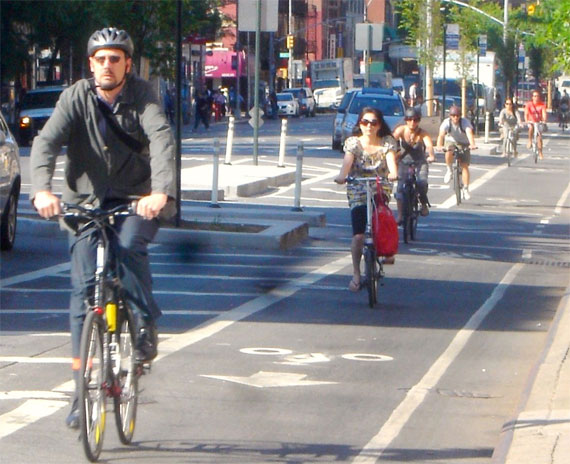If bicyclists want to convince policymakers of the benefits of cycling, they need to stop talking about cycling. That was one major lesson of this year’s National Bike Summit, thanks to some strategic research done by a friendly consultant. So the Summit’s theme was “Bicycling Means Business” – and the economic impacts of a healthy cycling culture don’t end with the cyclist.

“Bicycling is a good investment, not just for cyclists, but for the entire city, state and region,” said the Bike League’s Darren Flusche at a morning panel of the Summit. He warned activists against showing up to a lawmaker’s office and spewing data without the personal narratives that really get people’s attention. But data is important to back up that personal testimony – and here’s the data.
Business Is Booming, Thanks to Bikes
As Janette Sadik-Khan told the Women’s Bike Forum, businesses on Eighth and Ninth Avenues in New York saw a 50 percent increase in sales receipts after protected bike lanes were installed on the corridor. On San Francisco’s Valencia Street, two-thirds of the merchants said bike lanes had been good for business. If a business has a bike-share station out front, bike-share users are more likely to patronize it.
Chuck Marohn of Strong Towns told the story of a Memphis neighborhood where people, without authorization, spent $500 on paint and made their own bike lanes. Six months later, commercial rents on the strip had doubled, and all the storefronts – half of which had been vacant – were full.
Bike Infrastructure Is a Better Value Than Car Parking
Businesses in some cities are also beginning to see the spatial logic of the bicycle. After all, 12 bikes fit in one car parking space. Providing bike parking is also an extraordinary bargain compared to building structured parking: one parking space in a garage costs at least $15,000 to build and hundreds of dollars per year to maintain, while building a rack for two bikes costs $150 to $300.
“A lot of people would say, ‘OK, fine, that’s all good and well for Portland’ – and now we have to add ‘and Minneapolis,’ and now we have to add ‘and Indianapolis,’” said Flusche. “The list keeps getting longer and longer.” He predicted that in 10 years, Tulsa, Oklahoma would be “the progressive city we’re talking about in this room.”
One Mile of Wider Asphalt = 600 Miles of Bike Lanes

But in Tulsa, right now, they’re spending $30 million to widen one mile of Yale Avenue. “With that $30 million, what could they have bought?” asked Flusche. “Six hundred miles of bike lane, 100 miles of sidewalk, 300 miles of buffered bike lanes, 120 miles of bicycle boulevards, 30 miles of first-rate bike trails, 20 miles of really elite physically separated cycle tracks, or 2,000 rapid flashing beacons for pedestrian safety.”
Another famous example of the cost-effectiveness of bicycling and walking investments: Portland built its entire bicycle network, up until 2008, for the cost of one mile of urban four-lane freeway. Put another way: the entire federal allocation for the Transportation Alternatives program – which underwrites active transportation projects and much more – would pay for just 10 or 20 miles of highway.
Plus, building a freeway means spending a ton of money on materials. Bike facility construction generally has a much better ratio of labor to materials, meaning that bike facilities create more jobs per dollar than new roads.
Bringing It Home
Those new bike facilities aren’t just good for the bottom line of adjacent businesses – they’re also good for nearby property owners, who see their property values rise. A home near Indianapolis’ Monon trail is worth 11 percent more than a home a half mile away, Flusche noted. Each WalkScore point is worth $700 to $3,000 in the price of a house.
Streets that accommodate all users -- including cyclists, pedestrians, and transit riders -- mean less traffic congestion and better quality of life. Not surprisingly, then, they are also linked to higher commercial property values and lower vacancy rates, according to Marohn.
Add to this the simplest calculation of all: car costs saved. The IRS estimates the cost of driving to be 56.5 cents per mile. AAA estimates the average annual cost of car ownership to be near $9,000. Energy regulation expert Ken Colburn -- also a cycling instructor with the Bike-Walk Allinace of New Hampshire -- said the top reason for mortgage disapproval is that people’s car payments are too high, making them a bad credit risk. “The probability of foreclosure increases with car ownership,” he said.
Convinced? Go tell it to your Congressmember.





